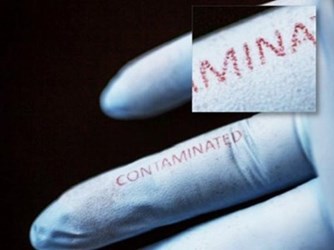New Silk-Based Ink Can Detect Bacteria, Could Enable "Smart" Bandages

A new bioink made from silk has successfully been printed onto hospital gloves and changes color when it comes into contact with certain kinds of bacteria. Researchers at Tufts University say that certain properties of the silk protect heat-sensitive biomolecules during the ink-jet printing process, and that the method could open the door to a host of new therapeutic, biosensor, and regenerative medicine applications.
The silk acts as a “cocoon for biological matter” that stabilizes compounds like enzymes, antibodies, growth factors, nanoparticles, and antibiotics, said Fiorenzo Omenetto, a Tufts University professor of physics and senior author of the researchers’ paper published in Advanced Materials. The “cocoon” allows the biological compounds to retain their functions after being ink-jet printed.
“We thought that if we were able to develop an inkjet-printable silk solution, we would have a universal building block to generate multiple functional printed formats that could lead to a wide variety of applications in which inks remain active over time,” Omenetto said in a Tufts Now article.
Omenetto’s team used the process to develop a pair of hospital gloves with the word “contaminated” printed onto the finger using silk ink mixed with polydiacetylenes. These inks react when they come into contact with E.coli, turning the text from blue to red.
The study, conducted by a team of scientists from Tufts University and the University of Illinois Urbana-Champaign, found that the biomaterials approach permits a “system utility [that] can be controllably reconfigured ab initio to enable multiple end uses.” By using silk-fibroin as a base material, scientists were able to create a “custom library” of inkjet-printable inks.
The study included a number of their different experiments, including paper tests, biosensors, and methods for testing the efficacy of topographically applied antibiotics. Because silk-base preparation is a water-based process, researchers noted that they did not need extra solvents or chemicals that could interfere with the integrity of the added compounds.
The researchers told Tufts Now that future applications could yield biosensing gloves that react to a variety of pathogens, or “smart” bandages that could sense infections and deliver drugs as needed.
Omenetto has been a long-time proponent of silk as a viable biomaterial and has introduced a variety of silk-based biomedical products. In Feburary, a team led by Omenetto introduced a bioresorbable, silk-and-magnesium implant that could be wirelessly triggered from outside the body to fight bacteria.
In a 2011 Ted Talk, Omenetto called silk a “new, old material” and commented, “We’re impassioned with this idea that whatever you want to do, whether you want to replace a vein or a bone, or maybe be more sustainable in microelectronics… maybe carry your drugs in your pocket… or deliver them across the desert, the answer may be in a thread of silk.”
